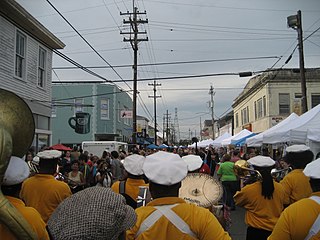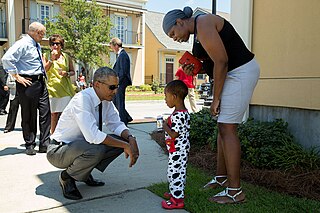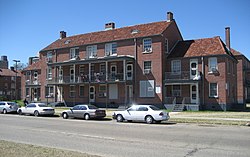
Storyville was the red-light district of New Orleans, Louisiana, from 1897 to 1917. It was established by municipal ordinance under the New Orleans City Council, to regulate prostitution. Sidney Story, a city alderman, wrote guidelines and legislation to control prostitution within the city. The ordinance designated an area of the city in which prostitution, although still nominally illegal, was tolerated or regulated. The area was originally referred to as "The District", but its nickname, "Storyville", soon caught on, much to the chagrin of Alderman Story. It was bound by the streets of North Robertson, Iberville, Basin, and St. Louis Streets. It was located by a train station, making it a popular destination for travelers throughout the city, and became a centralized attraction in the heart of New Orleans. Only a few of its remnants are now visible. The neighborhood lies in Faubourg Tremé and the majority of the land was repurposed for public housing. It is well known for being the home of jazz musicians, most notably Louis Armstrong as a minor.

Tremé is a neighborhood in New Orleans, Louisiana. "Tremé" is often rendered as Treme, and the neighborhood is sometimes called by its more formal French name, Faubourg Tremé; it is listed in the New Orleans City Planning Districts as Tremé / Lafitte, from when including the Lafitte Projects.

The Central Business District (CBD) is a neighborhood of the city of New Orleans, Louisiana, United States.

Broadmoor is a neighborhood of the city of New Orleans. A subdistrict of the Uptown/Carrollton Area, its boundaries as defined by the New Orleans City Planning Commission are: Eve Street to the north, Washington Avenue and Toledano Street to the east, South Claiborne Avenue to the south, and Jefferson Avenue, South Rocheblave Street, Nashville Avenue, and Octavia Street to the west. It includes the Broadmoor Historic District which was listed on the National Register of Historic Places in 2003 and increased in its boundaries in 2007.

Central City is a neighborhood of the city of New Orleans. It is located at the lower end of Uptown, just above the New Orleans Central Business District, on the "lakeside" of St. Charles Avenue. A subdistrict of the Central City/Garden District Area, its boundaries as defined by the City Planning Commission are: MLK Boulevard, South Claiborne Avenue and the Pontchartrain Expressway to the north, Magazine, Thalia, Prytania and Felicity Streets and St. Charles Avenue to the south and Toledano Street, Louisiana Avenue and Washington Avenue to the west. This old predominantly African-American neighborhood has been important in the city's brass band and Mardi Gras Indian traditions.

The Agriculture Street Landfill was a dump located in the Desire Area of New Orleans, Louisiana. The area was later developed for residential use, with unfortunate environmental consequences. It became a Superfund cleanup site in 1994.

The Magnolia Projects, officially the C. J. Peete Public Housing Development, was one of the Housing Projects of New Orleans. As part of the ongoing redevelopment, the area has been renamed Harmony Oaks. The project was among the largest, housing approximately 2,100 people. It is also home to numerous hip-hop artists; it has been referred to as "Magnolia: Home of the Soulja." Located in the part of uptown New Orleans known as Central City, it was bounded by Louisiana Avenue, South Claiborne Avenue, La Salle Street and Washington Avenue. The Magnolia Projects are located within the 11th and 12th Wards of New Orleans. At its height, the Magnolia projects had 1403 units.

The Housing Authority of New Orleans is a housing authority in New Orleans, Louisiana, tasked with providing housing to low-income residents.
Desire Projects was a housing project located in the Ninth Ward of New Orleans, Louisiana. These projects were the largest in the nation and consisted of about 262 two-story brick buildings, containing about 1,860 units across 98.5 acres of land. The overall conditions of the projects were deplorable from the moment they were put into place in the later part of the 1950s. The projects were meant to serve the large number of underprivileged African American residents in the New Orleans area. Soon it became a place of despair, and Desire eventually evolved into a dark no-man’s land, leaving many residents infested with problems and little or no help from the government. Located in a cypress swamp and dumping ground, Desire was known as the poorest housing development in New Orleans—-it was bordered by railroad tracks, the Mississippi River, the Industrial Canal and a corridor of industrial plants. Historically the Desire was the city's most dangerous housing project and was documented as being one of the deadliest communities in the country. Most of the crime was due to drugs like Heroin that have plagued the project since the late 1960s. When crack cocaine arrived in the mid-1980s, the crime rate in the Desire increased, and violence intensified. As residents began moving out to flee the physical and social decay, abandoned apartments provided convenient places to stash drugs; drug deals and killings were commonplace. Desire's alleys and courts became a place where life was sometimes worth less than a pair of basketball shoes. The uptick in murders gave Desire a reputation for violence along with the nearby Florida Projects. In 1995, murders drastically decreased in the Desire project and the Florida development. The nightly gunfire that frequently shattered sleep in the Desire was largely gone; so were the outsiders who once grouped menacingly in the courtyards. That same year in February the U.S. Department of Housing and Urban Development approved a HOPE VI grant to HANO to improve the living environment through rehabilitation of the housing. Mass demolition began in 1997 and was completely razed by 1999.

St. Bernard Projects was a housing project in the city of New Orleans. A subdistrict of the Mid-City District Area, its boundaries as defined by the New Orleans City Planning Commission were: Harrison Avenue to the north, Paris Avenue to the east, Lafreniere Street and Florida Avenue to the south and Bayou St. John to the west.

The Melpomene Projects, officially called the Gustavo Apartments or TheGuste Homes, and colloquially The Melph, are a housing complex located in the Central City neighborhood of New Orleans.

The Lafitte Projects were one of the Housing Projects of New Orleans and were located in the 6th Ward of New Orleans Treme neighborhood. It was one of Downtown New Orleans' oldest housing developments and had many associated problems before being severely flooded and damaged during Hurricane Katrina in 2005. The project made national headlines after the gruesome murder of Thomas May who burned to death in the project in 1994. By a Department of Housing and Urban Development (HUD) decree, the projects were demolished and redeveloped as affordable, mixed-income housing. The redevelopment effort was charged with replacing every demolished unit. The large housing project was left mostly vacant following evacuations after the extensive flooding from Hurricane Katrina. Heated arguments have surrounded the demolition of the project, as some longtime residents wanted them renovated.

Internally displaced persons in the United States are people from the Gulf States region in the southern United States, most notably New Orleans, Louisiana, who were forced to leave their homes because of the devastation brought on by Hurricane Katrina in 2005 and were unable to return because of a multitude of factors, and are collectively known as the Gulf Coast diaspora and by standard definition considered IDPs. At their peak, hurricane evacuee shelters housed 273,000 people and, later, FEMA trailers housed at least 114,000 households. Even a decade after Hurricane Katrina, many victims who were forced to relocate were still unable to return home.

Claiborne Avenue is a major thoroughfare in New Orleans, Louisiana. It runs the length of the city, about 9.5 miles (15.3 km), beginning at the Jefferson Parish line and ending at the St. Bernard Parish line; the street continues under different names in both directions. It is called South Claiborne Avenue upriver from Canal Street and North Claiborne Avenue from Canal to St. Bernard Parish.

Leonidas is a neighborhood designation in the city of New Orleans. A subdistrict of the Uptown/Carrollton Area, its boundaries as defined by the New Orleans City Planning Commission are: South Claiborne Avenue, Leonidas and Fig Streets to the north, South Carrollton Avenue to the east, the Mississippi River and Jefferson Parish to the west. Although an official city planning district name, the name "Leonidas" is not widely used nor has it any historical usage and the area is usually referred to by the larger neighborhood "Uptown, or "Carrollton".

Tulane/Gravier is a neighborhood of the city of New Orleans, Louisiana, U.S.A. A subdistrict of the Mid-City District Area, its boundaries as defined by the New Orleans City Planning Commission are: St. Louis Street to the north, North Claiborne Avenue, Iberville Street, North and South Derbigny Street, Cleveland Street, South Claiborne Avenue to the east, the Pontchartrain Expressway to the south and South Broad Street to the west.

New Faubourg Lafitte is a residential development in New Orleans, Louisiana, U.S.A. It largely occupies the area formerly filled by the since demolished Lafitte Projects public housing.
Pigeon Town is a New Orleans, Louisiana neighborhood located in the 17th Ward of New Orleans and within the larger Carrollton neighborhood, and within the area that the New Orleans city planning commission calls "Leonidas." Pigeon Town is (loosely) bordered by Cambronne St. (East), Claiborne Ave. (north), Oak St. (South) and the Orleans-Jefferson parish line on the west. It is situated directly between the Hollygrove neighborhood and the Oak Street Cultural Arts District.
The Calliope Projects, also known as B. W. Cooper Public Housing Development, was a neighborhood of the city of New Orleans and one of the housing projects of New Orleans. This project of New Orleans gained notoriety for its extremely high violent crime rate and was known to be one of the most violent housing projects in the United States. It was demolished in 2014 and replaced with newer, mixed-income apartment buildings.
Behrman also known as "Behrman Heights," is a crime-ridden low income community located in Algiers, New Orleans It was named after popular New Orleans mayor Martin Behrman, and is nestled south of the US Naval Support neighborhood and north of Tall Timbers/Brechtel, flanked on the west by Fischer Housing Development and Whitney, and on the east by Old Aurora.

















